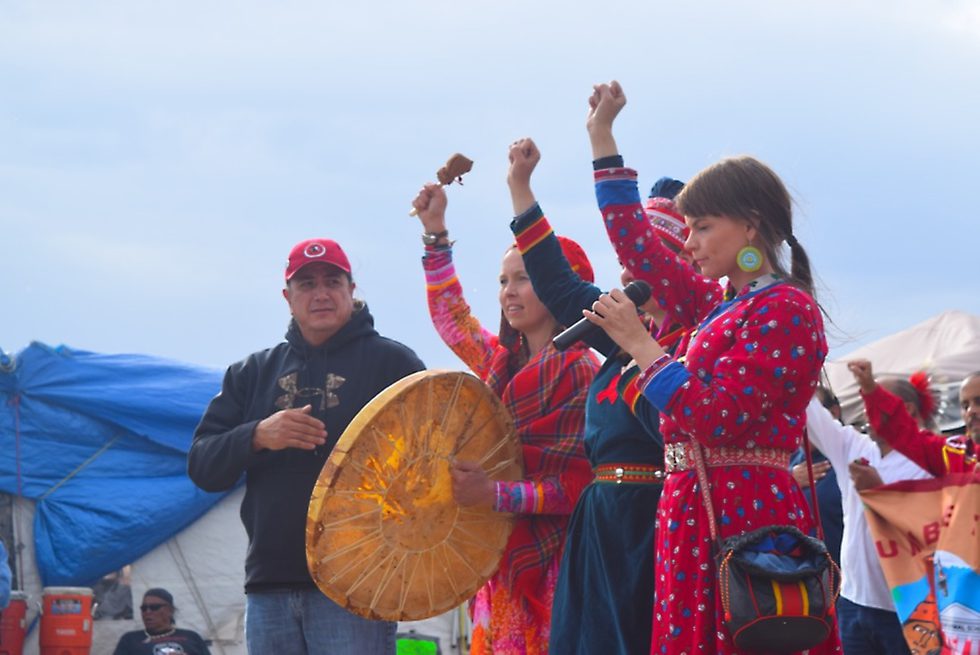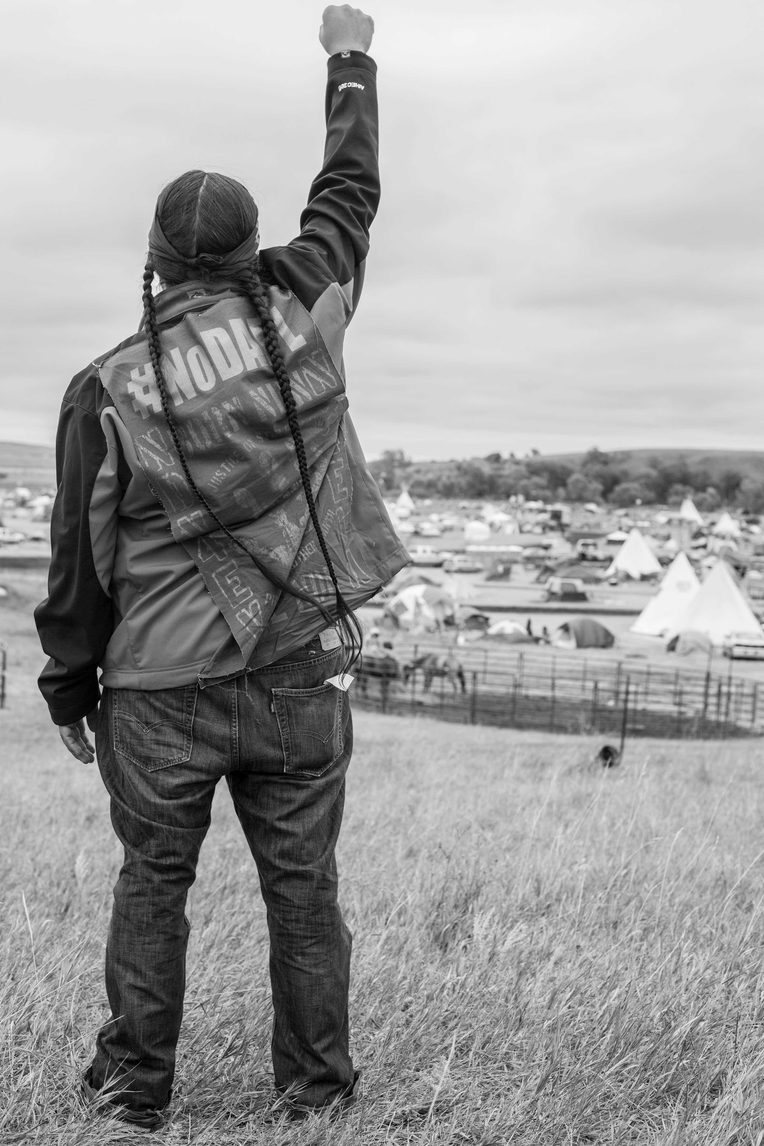Introduction: Standing Rock, #NoDAPL, and Mni Wiconi
From the Series: Standing Rock, #NoDAPL, and Mni Wiconi
From the Series: Standing Rock, #NoDAPL, and Mni Wiconi

Fear and uncertainty define this historical moment, but they must not guide it. Even as politicians and mainstream media attempt to normalize a bigot and racist elected to the U.S. presidency, the Oceti Sakowin (Great Sioux Nation) has spearheaded historic resistance against the Dakota Access Pipeline (DAPL), the fossil fuel industry, and ongoing state violence against Indigenous bodies as well as the land, water, and air. More than three hundred Native nations and allied movements have planted their flags in solidarity at Oceti Sakowin Camp, the largest of several camps including (including Red Warrior Camp and Sacred Stone Camp) north of the Hunkpapa Oyate, the Standing Rock Sioux Indian Reservation. The main camp is home to thousands who have vowed to defend and uphold the 1851 and 1868 Fort Laramie Treaties on land and water now claimed by the U.S. Army Corps of Engineers after it was flooded in the 1950s and 1960s. The treaties guarantee the Oceti Sakowin sole jurisdiction of Mni Sose, the Missouri River. The Water Protectors, as they call themselves, challenge and redefine the ambit of legal jurisdiction that legitimates settler sovereignty.

As Craig Howe (Lakota), Tyler Young, Edward Valandra (Lakota), and Kim TallBear (Dakota) poignantly remind us, Mni Sose is not a thing that is quantifiable according to possessive logics. Mni Sose is a relative: the Mni Oyate, the Water Nation. She is alive. Nothing owns her. Thus, the popular Lakotayapi assertion “Mni Wiconi”—water is life or, more accurately, water is alive. You do not sell your relative, Water Protectors vow. To be a good relative mandates protecting Mni Oyate from the DAPL’s inevitable contamination. This is the practice of Wotakuye (kinship), a recognition of the place-based decolonial practice that Yellow Knives Dene scholar Glen Coulthard calls grounded normativity.
The #NoDAPL struggle is a continuation of the nineteenth-century Indian wars of extermination. It is the classic settler-colonial scenario: Natives are seen as impediments to progress, which therefore must be eliminated. Put simply, Indians block unrestricted capitalist accumulation. It is no coincidence that the main police force, the Morton County sheriff’s department, which has brutalized Water Protectors and has made more than five hundred arrests, descends from the infamous Seventh Calvary general, George Armstrong Custer. The connections are clear: Custer was stationed at Fort Lincoln (present-day Mandan, North Dakota, the county seat of Morton County) to ensure the safe construction of a transcontinental railroad across Mni Sose and through Oceti Sakowin territory. The fort took its name from the so-called Great Emancipator, who ordered the hanging of thirty-eight Dakota men as punishment for the 1862 Dakota Uprising, which remains the largest mass execution in U.S. history. From Fort Lincoln Custer led several expeditions into He Sapa, the Black Hills, in search of gold. His last sortie to the Little Bighorn Mountains in 1876 aimed to wipe out a supposedly hostile Native camp numbering in the thousands. On June 25, 1876, Custer’s Seventh Cavalry met its demise at the hands of a Cheyenne, Arapaho, and Oceti Sakowin confederacy at the Battle of Greasy Grass. Today, Morton County, the white-dominated border towns of Mandan and Bismarck, and the state of North Dakota under the leadership of Governor Jack Dalrymple fulfill Custer’s legacy of flagrant anti-Indianism, trespass, and retributive, carceral violence.
Mni Wiconi embodies the strength and wisdom of ancestral anticolonial struggles imprinted on the land and Mni Sose. It is also situated in the power and leadership of Indigenous youth and Indigenous women, who are foregrounding the way that colonialism functions through race, class, gender, and sexuality to create interlocking systems of oppression. Mni Wiconi simultaneously speaks to the past, present, and future—catapulting us into a moment of critical, radical reflection about the colonial wounds and wounding in the spaces between calls to save planet Earth and the everyday sociopolitical realities facing Indigenous peoples.
Accordingly, this Hot Spots series takes up the following questions: How do we situate Standing Rock within a social, political, cultural, and historical context of Indigenous anticolonial resistance against occupation and various forms of state violence inherent to settler colonialism? How do we understand Indigenous resurgence as making discursive and theoretical interventions in the dominant climate-justice movement by foregrounding relationality to land, water, and air through Indigenous epistemologies and ontologies? How does the pivotal leadership of Indigenous youth and the convergence of allied struggles inform transformative political possibilities for decolonization? Finally, how are social movements and academic fields of study accountable to Indigenous nations in the #NoDAPL movement with respect to research agendas, advocacy strategies, and education-based interventions?
Since we began working on this series several months ago, much has happened. There has been a profound escalation in state violence against the Water Protectors through the militarization of policing units. Attack dogs, handcuffs, flex cuffs, assault rifles, flood lights, infiltrators, agitators, sound cannons, armored personnel carriers, private property, tear gas, mace, Humvees, the North Dakota National Guard, seventy-six law enforcement agencies, $17 million of disaster-relief money for policing, strip searches, concrete barricades, concussion grenades that rip apart bone and flesh, airplanes, and helicopters are all technologies of policing and social control that have been used to quell #NoDAPL.
Despite all of this, #NoDAPL has prevailed, claiming victory on December 4, 2016 when the Army Corps of Engineers denied the easement for the Dakota Access Pipeline to cross the Missouri River under Lake Oahe. While the fight continues, this decision signals the power of Indigenous collective strength and reveals what is possible when people stand together to protect life. As each of the writers in this series makes clear, this epic resistance signifies a movement to reclaim Native lives, lands, and water that has been created in conjunction with allied struggles in support of a transformative anticolonial agenda centering Indigenous sovereignty, territorial restoration, land reclamation, and the eradication of colonial gender violence. We hope their perspectives contribute to ongoing public dialogue, direct action campaigns, and strategic organizing efforts against the DAPL as well as resistance to similar neoliberal development projects on Indigenous territories across the world. After all, Standing Rock is one of many front lines.
Jaskiran Dhillon is a first-generation academic and organizer who grew up on Treaty Six Cree Territory in Saskatchewan. She is Assistant Professor of Global Studies and Anthropology at The New School in New York City. Her first book, Prairie Rising: Indigenous Youth, Decolonization, and the Politics of Intervention is forthcoming with the University of Toronto Press in 2017.
Nick Estes is Kul Wicasa from the Lower Brule Sioux Tribe, a doctoral candidate in American Studies at the University of New Mexico, and an Andrew W. Mellon Dissertation Fellow. His forthcoming book Mni Wiconi: Water is Life, Death, and Liberation will be published by Verso in 2017.